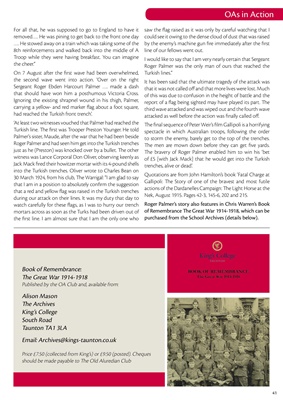
41
OAs in Action: True Stories from the First World War
For all that, he was supposed to go to England to have it
removed…. He was pining to get back to the front one day
…. He stowed away on a train which was taking some of the
8th reinforcements and walked back into the middle of A
Troop while they were having breakfast. You can imagine
the cheer."
On 7 August after the first wave had been overwhelmed,
the second wave went into action. 'Over on the right
Sergeant Roger Ebden Harcourt Palmer …. made a dash
that should have won him a posthumous Victoria Cross.
Ignoring the existing shrapnel wound in his thigh, Palmer,
carrying a yellow- and red marker flag about a foot square,
had reached the Turkish front trench'.
'At least two witnesses vouched that Palmer had reached the
Turkish line. he first was Trooper Preston Younger. He told
Palmer's sister, Maude, after the war that he had been beside
Roger Palmer and had seen him get into the Turkish trenches
just as he (Preston) was knocked over by a bullet. he other
witness was Lance Corporal Don Oliver, observing keenly as
Jack Mack fired their howitzer mortar with its 4-pound shells
into the Turkish trenches. Oliver wrote to Charles Bean on
30 March 1924, from his club, he Warrigal: "I am glad to say
that I am in a position to absolutely confirm the suggestion
that a red and yellow flag was raised in the Turkish trenches
during our attack on their lines. It was my duty that day to
watch carefully for these flags, as I was to hurry our trench
mortars across as soon as the Turks had been driven out of
the first line. I am almost sure that I am the only one who saw the flag raised as it was only by careful watching that I
could see it owing to the dense cloud of dust that was raised
by the enemy's machine gun fire immediately after the first
line of our fellows went out.
I would like to say that I am very nearly certain that Sergeant
Roger Palmer was the only man of ours that reached the
Turkish lines."
It has been said that the ultimate tragedy of the attack was
that it was not called off and that more lives were lost. Much
of this was due to confusion in the height of battle and the
report of a flag being sighted may have played its part. he
third wave attacked and was wiped out and the fourth wave
attacked as well before the action was finally called off.
he final sequence of Peter Weir's film Gallipoli is a horrifying
spectacle in which Australian troops, following the order
to storm the enemy, barely get to the top of the trenches.
he men are mown down before they can get five yards.
he bravery of Roger Palmer enabled him to win his 'bet
of £5 [with Jack Mack] that he would get into the Turkish
trenches, alive or dead'.
Quotations are from John Hamilton's book 'Fatal Charge at
Gallipoli: he Story of one of the bravest and most futile
actions of the Dardanelles Campaign: he Light Horse at the
Nek, August 1915. Pages 42-3, 145-6, 202 and 215.
Roger Palmer's story also features in Chris Warren's Book
of Remembrance he Great War 1914-1918, which can be
purchased from the School Archives (details below).
OAs in Action
BOOK OF REMEMBRANCE
The Great War 1914-1918
BOOK OF REMEMBRANCE
The Great War 1914-1918
1907 King's College Officers' Training Corps. Of the 100 cadets that year 30 were to die in the Great War
Book of Remembrance:
he Great War 1914-1918
Published by the OA Club and, available from:
Alison Mason
he Archives
King's College
South Road
Taunton TA1 3LA
Email: archives@kings-taunton.co.ukgs-taunton.co.uk" target="_blank" title="Visit kings-taunton.co.uk">kings-taunton.co.uk
Price £7.50 (collected from King's) or £9.50 (posted). Cheques
should be made payable to he Old Aluredian Club